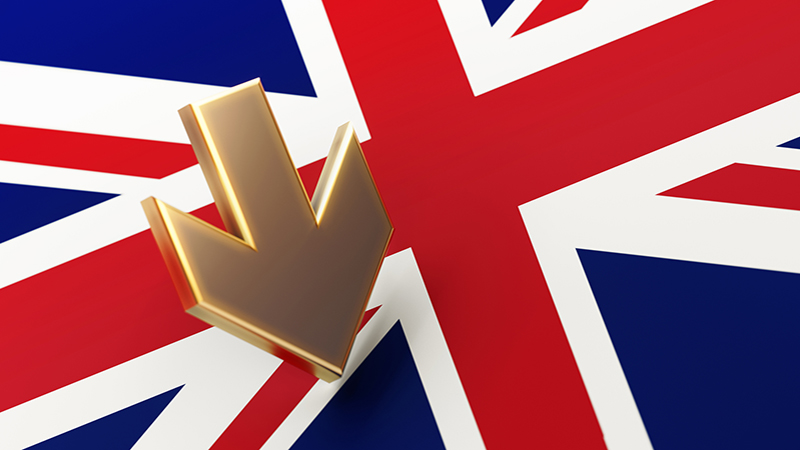UK inflation fell from 4% to 3.4% in February this year, according to today’s Consumer Price Index (CPI) figures, which marks a lower-than-anticipated fall. Core inflation also fell by six percentage points, from 5.1% to 4.5% in January.
The largest contributor was falling food prices alongside the communication sector, although housing and fuel costs crept higher during the month.
Zara Nokes, global market analyst at JP Morgan Asset Management (JPMAM), said: “Following a torrid couple of years for UK households, this morning’s inflation print is yet further evidence that the outlook for consumers is brightening.
“More good news should be on the way with headline inflation likely to drop below the 2% inflation target in the spring, but crucially, this is largely being driven by a transitory fall in energy prices. The bank will instead be keeping a watchful eye on the medium-term inflation outlook, particularly the domestically-generated inflation originating from the services sector.
Looking over the coming months, industry commentators expect inflation to fall further still with the fall of energy bills.
Tom Stevenson, investment director at Fidelity International, said: “Inflation is likely to continue dropping through the spring as cheaper gas and electricity from April drives household energy costs lower. The key unanswered question is whether, and by how much, price growth bounces back from target in the second half of the year – the bank’s central expectation.”
Lindsay James, investment strategist at Quilter Investors, added: “The plunge in energy bills anticipated in April could see an even greater fall in headline figures, aligning with the Office for Budget Responsibility’s expectation that inflation will average out at 2.2% in 2024.
“However, economist forecasts for the medium term have considerable variance, highlighting risks that are still present around energy security, supply chain resilience and structural labour shortages.”
Central bank expectations
Despite today’s data, Stevenson said rates are expected to stay on hold “until June at least” and will “fall back only slowly from the current 5.25%”.
“Inflation may briefly touch the bank’s target in the next few months but is not expected to settle at 2% until 2026.
“This means homeowners expecting a significant easing in mortgage rates this year face higher for longer borrowing costs. This will keep a lid on the nascent housing recovery that has seen prices stabilise in the past few months.
“The UK stockmarket meanwhile, has lagged its rivals recently, and now looks good value as the economic and political backdrop improves.”
James pointed out that medium-term economic forecasts vary widely, which highlights prevailing risks around energy security, structural labour shortages and supply chain resilience.
“Wage growth has been a significant driver of inflation in the service economy for some months, and recent data showed this is now slowing a little. However, it will likely make the bank’s 2% target more difficult to achieve,” she said.
“This looks likely to remain a strong inflationary driver while there is an ongoing mismatch in the labour supply available and the level of demand on offer, with recent business surveys flagging that this pressure remains elevated and a cost they are passing through to customers in the form of price rises.
“Similarly, ongoing disruption to international shipping continues to put pressure on supply chains amid higher freight rates and longer lead times.”
Given signs that UK growth has returned – albeit modestly – the investment strategist said the inflation reading will “give a confidence boost to the Bank of England that inflation is now coming to heel”.
“As it looks likely to fall further in coming months, with the 12% cut to the energy price cap kicking in from April, the bank’s monetary policy committee will be under further pressure to consider rates cuts sooner rather than later.”
Neil Birrell, chief investment officer at Premier Miton Investors and lead fund manager on the Premier Miton Diversified funds, added: “[Today’s inflation figures] won’t be enough for a cut in interest rates in the very short term but does give backing to the view that the UK economy is performing. Rate cut expectations for the middle of the year are well founded.”
JP Morgan’s Nokes said: “While the Bank of England will cheer the decline in the headline figure, it is unlikely to be convinced that the battle against inflation is won.
“With regular wage growth north of 6% and services inflation still running hot, the bank will need further evidence that domestic price pressures are cooling before it begins cutting rates.”
Steve Matthews, investment director, liquidity at Canada Life Asset Management, said attention now turns to the Monetary Policy Committee’s two hawks, Jonathan Haskel and Catherine Mann, who voted for a rate hike last month.
“The fall to 3.4% might alleviate some concerns, leading Haskel or Mann to shift to hold at tomorrow’s committee meeting and signalling that a June cut could be on the cards,” he reasoned. “They will, however, still be wary of the 9.8% National Living Wage rise coming into force in April and the potential of this feeding inflation. Our view remains that a first cut of 25 basis points in August is still the most likely scenario.”







